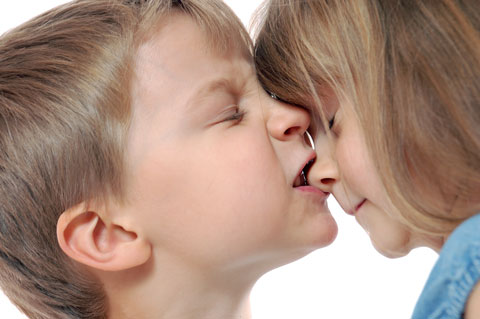Children who bite others hurt their peers and upset parents and teachers. Classmates may avoid the biters; adults may isolate them. So why do children bite? And how can we change this behavior?
Reasons Children Bite
- Infants probably bite as a way to explore objects, experiment, express excitement, or relieve teething pain.
- Toddlers are the most frequent biters. Toddlers may bite to express frustration before they have words to express their feelings. They also bite to get attention, to control a situation, or to imitate others who bite.
- Preschoolers bite as self-defense or to express anger or frustration. However, by the age of 3, most children can communicate their feelings and needs without biting. Frequent biting by a child over 3 may signal a serious behavior problem. Parents should discuss this behavior with the child’s health care provider or a counselor.
Responses to Biting
- Intervene immediately to stop the biting. Clearly state: “No biting! I don’t want you to bite anyone because it hurts, and I don’t want anyone to bite you, either.” Focus attention on the victim, not the biter. Remove the biter from the situation while giving first aid and comfort to the victim.
- Give an infant a safe teething object.
- Teach a toddler or preschooler words to use to express feelings or needs: “Jasmine, tell Luis not to take your blocks. Don’t bite him. Ask me for help if you need it.”
- Do not bite the child back, but keep him away from other children for as long as you feel he is upset and likely to bite again. Model the behavior you want to see in a child.
Actions to Prevent Future Biting
- Avoid labeling children as biters. Watch for positive behavior and reward it with your attention. “Tyler, may I join you for a few minutes? It’s fun to see what you’re building.”
- Make sure the child’s routine allows for adequate rest, food, and drink.
- Avoid overcrowding toddlers and include structured as well as unstructured activities.
- Help a child deal with stress. Teachers and parents can work together to reassure a child whose family is experiencing a major change. Encourage her to express feelings in words, through art, or through physical activity, such as punching clay or a toy.
Communicating with Parents
- Chart incidents of biting. Let parents know if their child was biting or if she was bitten. Confidentiality should be maintained so the identity of one child involved is not revealed to parents of another.
- Let parents know what steps teachers are taking to ensure the safety of all the children.
- Work with the parents of the child who bites to provide consistent responses to biting at home or at child care.
- Be sure all parents are aware of your program’s policies on biting or other aggressive behavior.


 PDF
PDF